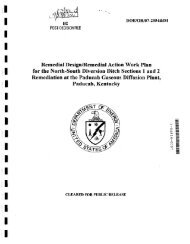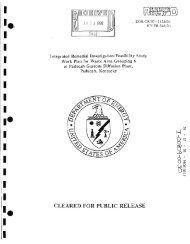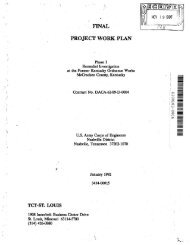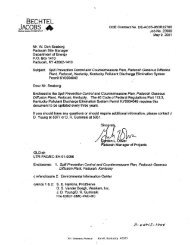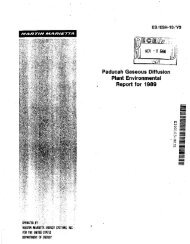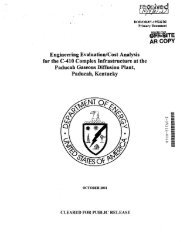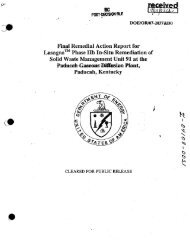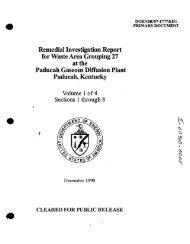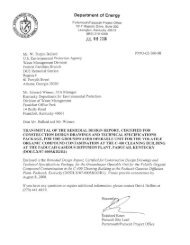1 - paducah environmental information center
1 - paducah environmental information center
1 - paducah environmental information center
You also want an ePaper? Increase the reach of your titles
YUMPU automatically turns print PDFs into web optimized ePapers that Google loves.
Paducah Site.<br />
(also known as an acute test) were conducted for<br />
Outfalls 015, 017, and 019, and longer term 6- or<br />
7-day toxicity tests (also known as a chronic test)<br />
were conducted for Outfall, 001. For the acute<br />
toxicity test data, the 48-hour LC so (concentration<br />
that is lethal to 50% of ,the· test organisms) was<br />
determined and Ithe acute toxicity unit (TU a) was<br />
calculated l (TU a<br />
= lOOILC so )' For the chronic<br />
toxicity tesrdata, the 25% inhibition concentration<br />
(IC25, that concentration causing a 25%<br />
reduction in fathead minnow growth<br />
Ceriodaphnia reproduction compared to a<br />
control) was determined and the chronic toxicity<br />
unit (TV c ) was calculated (TVc = 100IlC25). The<br />
TV a and TV c are compliance endpoints in the<br />
KPDES permit. For permitting purposes,<br />
KDOW has determined that Little Bayou and<br />
Bayou creeks have a low-flow zero; thus a TV ><br />
1.0 would be considered a noncompliance and<br />
an indicator of potential instream toxicity. A TV<br />
~ 1.2 is considered a significant noncompliance.<br />
During 1999, five toxicity exceedences<br />
were noted at KPDES Outfall 017. Details are<br />
provided in Sections 2 and 7· of this ASER.<br />
Terrestrial Wildlife<br />
Annual Deer Harvest<br />
found elevated in the muscle of background<br />
(Tables 8.4 and 8.5).<br />
In summary, there were no unusual<br />
findings in the 1999 deer data. When comparing<br />
Paducah Site deer data to the reference· deer data,<br />
the results were not substantially different. The<br />
data from future sampling events will continue to<br />
be assessed to identify any potential trends.<br />
Additional data is provided in Appendix C.<br />
Non-Routine Rabbit Sampling<br />
At the request of KDFWR, rabbit sampling<br />
was conducted in 1999. Muscle and fat tissue<br />
from seven rabbits collected at WKWMA were<br />
sampled for radionuclides (Section 5), PCBs,<br />
. and inorganic elements. No PCBs were detected<br />
in any samples. Copper, aluminium, iron,<br />
manganese, and zinc were detected in several<br />
muscle samples and barium was detected in one<br />
muscle sample. No regulatory standards exist by<br />
which to compare these results.<br />
Additional data is provided in Appendix C.<br />
The deer population in WKWMA is<br />
sampled annually to determine levels. of<br />
radionuclides (Section· 5), PCBs, and inorganic<br />
elements that might be attributed to past plant<br />
practices.. There were eight deer harvested from<br />
WiKWMA and two deer harvested from the<br />
BWMA to. serve as reference samples. There<br />
were no PCBs detected in the fat tissue, muscle,<br />
or liver samples of any of the ten deer harvested.<br />
Of the inorganics detected, all results for the<br />
WKWMA deer were comparable to the<br />
reference deer except for the presence of small<br />
amounts of barium, nickel; and copper in the<br />
liver of some WKWMA deer. Silver was found to<br />
be elevated in the muscle of a WKWMA deer and<br />
nickel was found elevated in another WKWMA<br />
deer. Beryllium, iron, vanadium, and zinc Were<br />
8-8<br />
Nonradiological Environmental Surveillance



